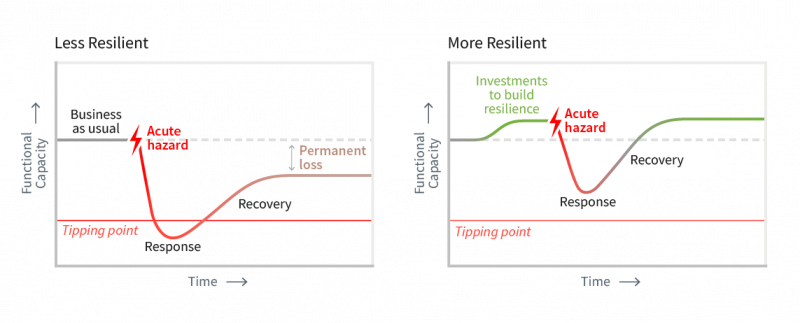Sections
Implementing the Steps to Resilience: A Practitioner's Guide is a user-friendly report containing a set of procedures to accompany each phase of the U.S. Climate Resilience Toolkit’s Steps to Resilience (StR). This document aims to support climate adaptation practitioners develop and implement equity-centered climate resilience plans in their communities.
The Steps to Resilience framework describes an iterative process to identify and address one's most pressing climate-related vulnerabilities and risk.
Following the Steps, groups compile a list of the things they care about (e.g., people, ecosystems, and economies) and evaluate which climate-related impacts could harm them. They assess which of their assets are vulnerable and at risk, investigate possible solutions, and make plans to address their greatest concerns. The framework also helps people recognize potential opportunities presented by changing climate conditions.
Resilience is the capacity of a community, business, or natural environment to prevent, withstand, respond to, and recover from a disruption. Climate resilience refers to situations where the disruptions are related to climate. These include events such as extreme weather, drought, and flooding. Efforts to build climate resilience are increasingly seen as opportunities to prepare for changing climate conditions, reduce emissions of greenhouse gases, and address issues of social equity. Building resilience means improving conditions so that the system can accommodate future disruptions.
Climate service provision must greatly accelerate in order for resilience to keep pace with climate challenges. This guide targets a narrow audience, namely climate adaptation practitioners who are working with local governments, non-profits, and communities that are ready and willing to use climate information to support decision making and that aim to create greater social equity in the process. Practitioners may come from the private and public sectors, academia, nonprofit organizations, and for-profit businesses. To be effective using this guide, practitioners must draw on a variety of skills and educational backgrounds.
To successfully implement a resilience plan, communities need capacity over the long term. Project implementation, monitoring and evaluation, community engagement about hazards and opportunities, ensuring that all relevant government operations incorporate up-to-date information about climate-related impacts, and sharing lessons learned with other practitioners all require staff with expertise and time to follow through.
Equity in climate resilience implies race, class, ability or other social characteristics do not determine preparedness for the impacts of climate variability and change.
A practitioner may employ the following five principles in efforts toward meaningfully incorporating equity in all phases of planning and implementation of climate resilience:
- Focus on root causes and community strengths
- Balance power dynamics
- Foster a sense of belonging
- Apply a place-based approach
- Evolve with the process

